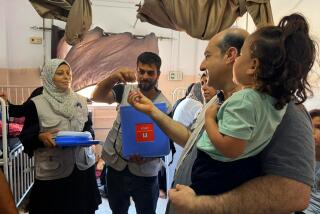Aftereffects of Polio May Hit Millions
- Share via
Eight million or more people worldwide who survived polio decades ago are about to face a new affliction as their disease comes back to haunt them in the form called post-polio syndrome, according to a report from a team of medical experts.
In the United States, the number of victims may range from 250,000 to 1 million.
There is no cure for post-polio syndrome, which leaves many victims in wheelchairs and on ventilators for the rest of their lives. Ironically, the most effective treatment for the disease is rest and the use of canes and wheelchairs--the exact opposite of the therapy that helped the victims survive their initial encounters with polio years earlier.
Unfortunately, few victims are receiving the proper therapy, because most physicians do not recognize the symptoms of post-polio syndrome and some even refuse to believe it exists, the report said.
“We are having difficulty in alerting the world medical community to the problems of post-polio syndrome,” said Dr. Lewis P. Rowland of the Columbia University College of Physicians and Surgeons. “Most doctors in their 40s or younger in developed countries have never even seen a case of polio, much less recognized a case of post-polio syndrome,” said the physician, who is chairman of the March of Dimes Steering Committee on Post-Polio Syndrome. The March of Dimes sponsored the new report.
But the disease is taking a savage toll on its victims. The symptoms include overwhelming fatigue, muscle weakness, muscle and joint pain, cold intolerance, sleep disorders, and breathing and swallowing problems.
The general consensus among most experts is that post-polio syndrome arises because the patient’s nerves simply wear out. Even people who survive polio suffer extensive nerve damage, because the virus destroys large numbers of nerve cells in victims’ muscles--60% or more in severely affected limbs. With intensive therapy, the remaining nerve cells are able to take over the function of the dead cells, restoring motion.
But years of overwork by those nerve cells takes a toll, leading them to begin dying off themselves, thereby once again producing the symptoms of the disease. The only way to slow the disease is to use the muscles less: by sitting instead of standing or using a wheelchair instead of walking.
“When patients were recovering from polio, we made them exercise their muscles and told them to ‘use it or lose it,’ ” said Dr. Richard Bruno, director of the Post-Polio Institute at Englewood Hospital and Medical Center in New Jersey. Now it is just the opposite. The byword is “Conserve to preserve.”
“If they can back off, listen to their bodies, and use assistive devices, either they don’t do any worse or they get significantly better,” Bruno said.
For survivors, however, “what’s difficult . . . is that we did manage to go on and get an education, have a job, get married and have kids and thought we put polio behind us,” said historian Daniel Wilson of Muhlenberg College in Allentown, Pa., a polio survivor who is studying the history of the epidemic.
Polio preyed on children and adolescents in the United States during the 1940s and 1950s, terrifying parents and placing thousands of young children in iron lungs. In 1955 alone, it killed 2,000 people and paralyzed 16,000. But the development of the Salk vaccine in 1955 and the Sabin vaccine six years later quelled the epidemic. By 1963, the U.S. had fewer than 100 cases a year, and by 1994 polio had vanished from the Americas.
The World Health Organization hopes to have polio eliminated globally by 2005. In 1998, with 82% of the world’s children vaccinated, there were only 3,200 cases. WHO estimates that there are at least 20 million polio survivors worldwide.
“In developing countries, where polio outbreaks still occur or have ended much more recently, medical systems will be facing post-polio syndrome for decades into the future and have little knowledge or understanding of it,” said Christopher P. Howson, director of global programs for the March of Dimes. The new report presents the first consensus guidelines for diagnosing the syndrome and treating it.
The total number of polio survivors in the United States is still a matter of dispute, because many mild cases were never diagnosed. Estimates range from 750,000 to 1.63 million survivors. The new report predicts that as many as 40% of those survivors will develop post-polio syndrome.
The March of Dimes report is available online at: www.modimes.org/Programs2/International/Default.htm.
The Post-Polio Institute’s Web site is: members.aol.com/harvestctr/pps/lib2.html.
Another good resource is the Gazette International Networking Institute at: www.post-polio.org.






